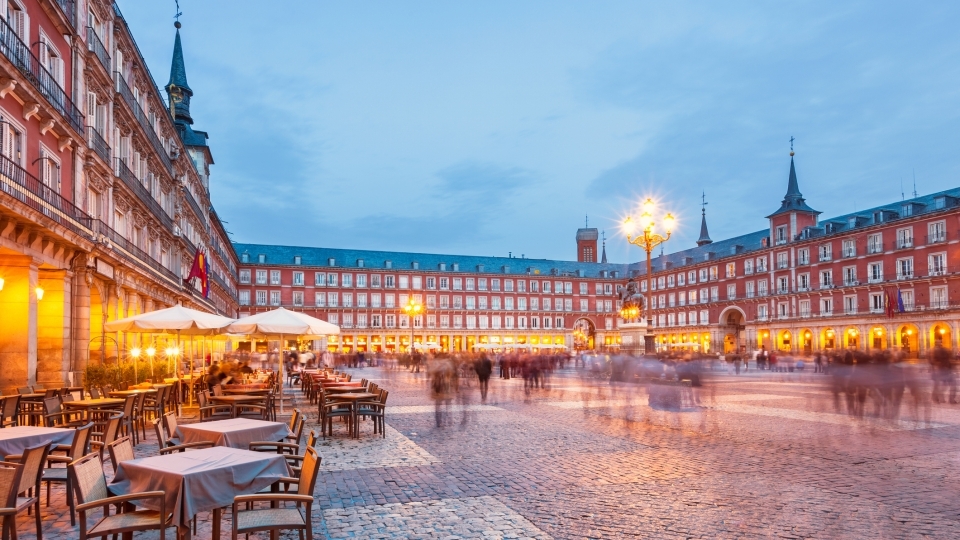President's Letter More Than a Taste of Culture
May 31, 2024

“Do you know Doug Hicks?”
My childhood friend Jon’s voice reverberated throughout the Madrid subway station as he shouted over the tracks to a student wearing a Davidson College sweatshirt.
It was spring 1989, and my friend Kitty Stout ’91 shouted back: “Know him? Doug is here on our Davidson in Madrid semester.”
Soon thereafter, much to my surprise, Jon showed up at my homestay family’s apartment to say hello. He was traveling around Spain on break from his own study abroad program. It was one of those connecting-of-worlds moments.
My Spanish “mother,” Ana, sensed that this was an important occasion for me, and she went to the butcher shop to bring back something special for lunch. It showed up on our plates: goat’s heads. Two halves, split open, for each of us. Or were they sheep’s heads? I still don’t know. All I can say is that I had a clear view of brains, tongue, eye sockets, and even a few whiskers.
When Ana saw my face, and Jon’s, she knew what we also knew: This was an unfortunate cross-cultural moment. She was generously wanting to celebrate a grand occasion, and we were struggling to eat this “delicacy.”
Jon immediately switched from Spanish to English and said to me, matter-of-factly, “What do we do now?” I responded with my strangely Solomonic decision: Let’s each eat one of the two halves as a sign of respect for Ana and her lovely intentions.
For me, this moment was particularly memorable because it happened against a backdrop of my profound love for Spanish food. Indeed, I recall fondly how much Davidson Professor Sandy Kemp taught us to understand Spanish culture and language through food—and, of course, Sandy’s favorite, vino tinto (red wine). The daily calendar revolved around meals—a basic breakfast, a coffee break between classes mid-morning, everyone home for a lengthy meal at lunch, siesta followed by a late afternoon of activity, then tapas or a late supper.
Meals, snacks, and drinks fostered community. Neighborhood social life happened in la plaza—the square—and in the restaurants and bars on the plaza. “Tapear,” to eat tapas in a progressive fashion from bar to bar, is an action verb in Spain. It is a call to spend time with friends and family.
In the ensuing 35 years, I have returned again and again to Spain, and each time, I am reminded of the many ways food and culture are intertwined. My spouse Catherine and I have traveled there a number of times, including a sabbatical research semester in Granada with our two children, aged three months and three years. Our younger child, Ada, was easy to please, but we had to figure out a plan to feed Noah.
It took us a few weeks to crack the cross-cultural code. At first, we tried to make Noah wait until 8 or 8:30 p.m., when the earliest restaurants opened for dinner. He was not a patient three-year-old. If we planned to go out for dinner, he would make the wait miserable. Then it occurred to us: “lunch” in southern Spain lasted until 4:30 or even 5 p.m. in many restaurants. We could simply go to restaurants at the end of their lunch hours and make it an early dinner for Noah.
It has also been a joyful part of my higher-ed career to take two groups of college students to Spain and help introduce them to Spanish culture through food. Last summer, I visited the Davidson in Cadiz students. What activity did I choose to do with them and with Catherine and Professor Kyra Kietrys? Dinner, of course! And, as I recalled with fondness my Spanish Professor Sandy Kemp, I raised a glass of tinto. She had taught me that in Spain at least, food is culture. And now I am able to carry that lesson forward to this generation of Davidson students.
Salud!
Originally published in the Spring/Summer 2024 print issue of the Davidson Journal Magazine; for more, please see the Davidson Journal section of our website.



